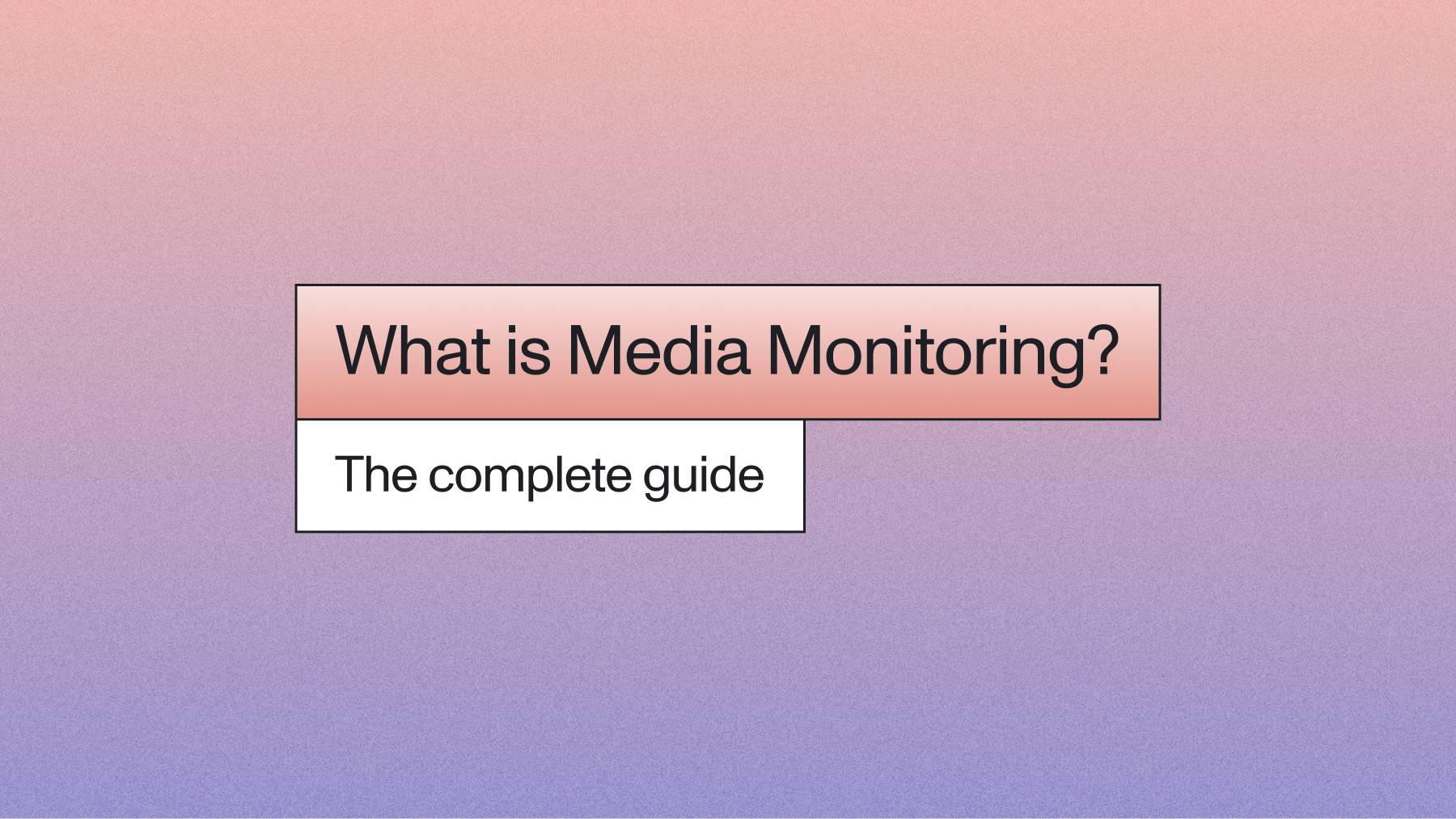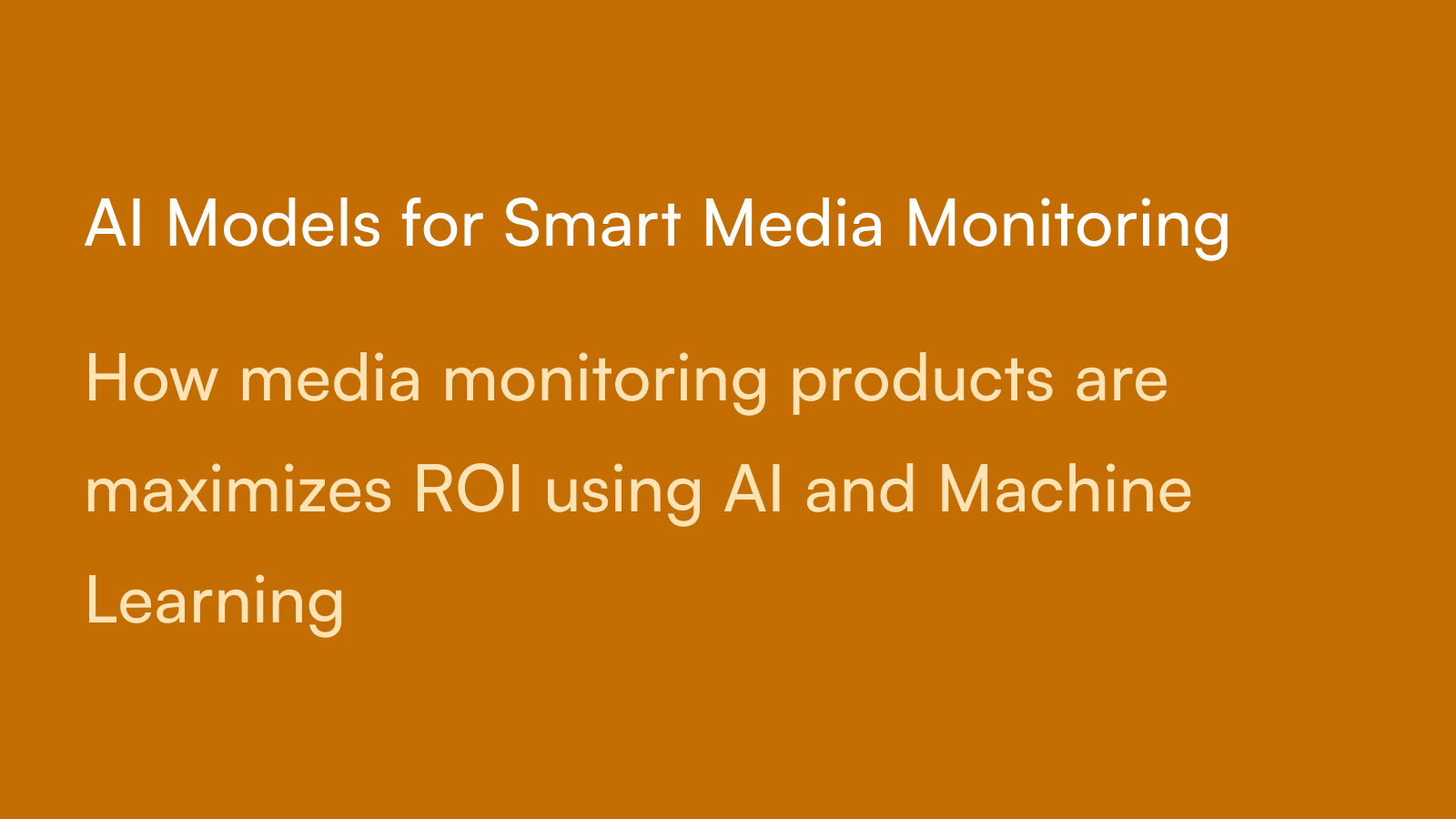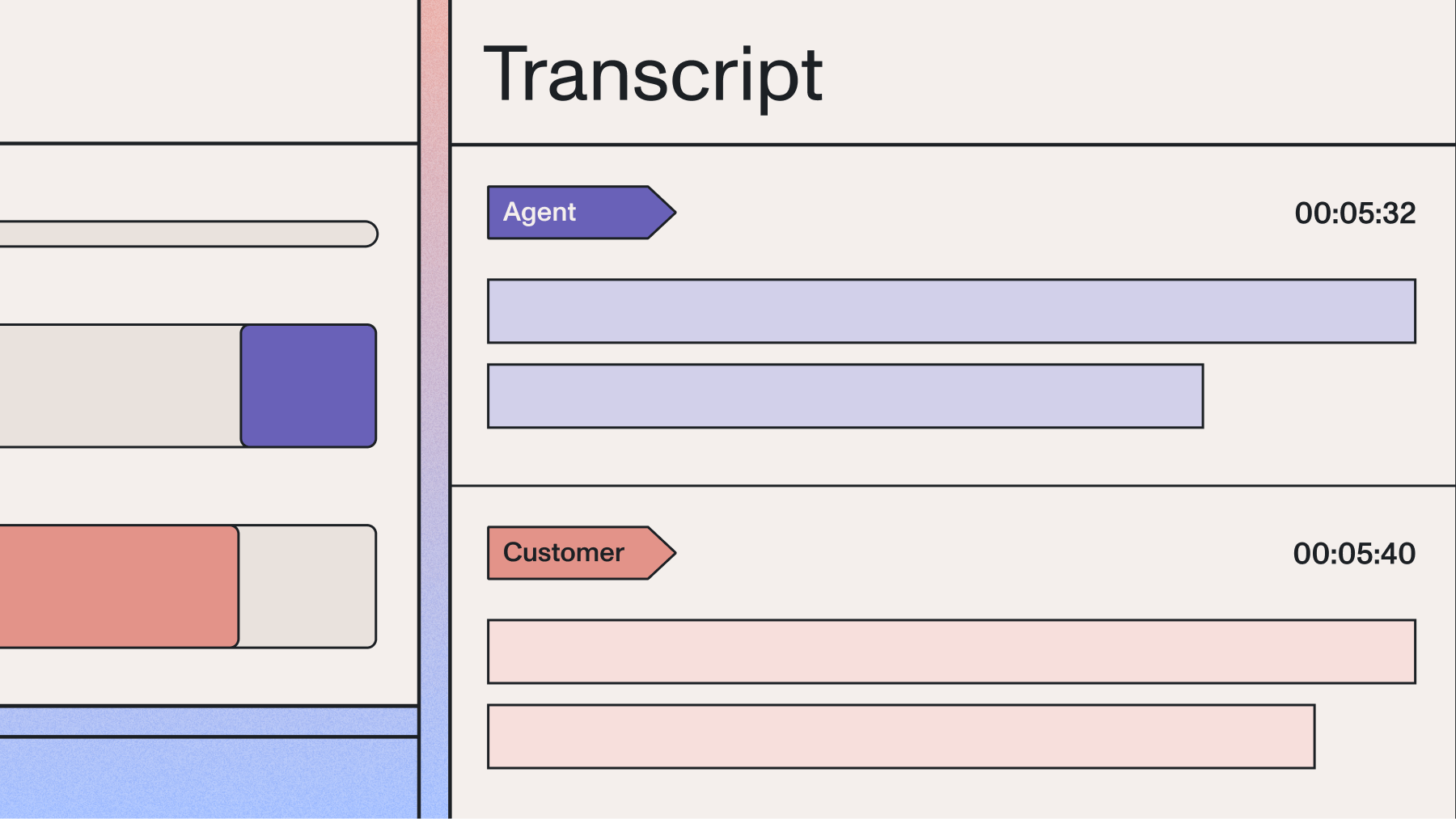What Is media monitoring? (Definition, Benefits, and AI)
Explore everything you need to know about media monitoring, including what it is, how it works, why you need it, and how AI can supercharge your efforts.



Media monitoring tracks brand mentions across digital channels to understand public perception and market dynamics. This intelligence shapes strategic decisions across marketing, customer service, and product development.
Modern Voice AI technology unlocks previously inaccessible content in podcasts, videos, and broadcasts. These AI models detect sentiment, extract insights, and process spoken-word content that traditional text monitoring completely misses.
This guide covers media monitoring fundamentals: what it encompasses, implementation strategies, AI advantages, and practical steps for building comprehensive monitoring systems that deliver competitive intelligence.
What Is media monitoring?
Media monitoring is the systematic process of tracking, collecting, and analyzing brand mentions across all media channels in real-time. Modern systems use AI to process conversations from social media, news sites, podcasts, and video content to understand public perception and market sentiment.
Traditional media monitoring focused on print publications, television broadcasts, and radio programs. Teams would manually scan newspapers, record TV segments, and track radio mentions—a labor-intensive process that captured only a fraction of available information. Today's digital landscape demands a more comprehensive approach that encompasses:
- Social media networks
- Online news sites
- Blogs and forums
- Podcasts and video content
- Television and radio broadcasts
- Print publications
- Review platforms
The fundamental purpose remains constant: staying informed about how the public perceives your brand. Your goal isn't just finding mentions—it's understanding the context, sentiment, and potential impact those mentions carry. This intelligence shapes strategic decisions across marketing, product development, customer service, and executive leadership.
Some organizations still approach media monitoring through manual processes, using platform-specific tools and human reviewers to track mentions individually. This approach quickly becomes overwhelming as conversation volume grows. Other organizations deploy smart media monitoring solutions that automatically scan vast amounts of content with AI-powered accuracy and scale.
For example, businesses use AssemblyAI's AI models to analyze media content across podcasts, video platforms, and broadcast media. These models automatically identify brand mentions while understanding the surrounding context—whether discussions are positive or negative, which topics arise frequently, and what competitive comparisons emerge.
Types of media monitoring
Media monitoring encompasses distinct approaches, each serving specific business objectives. Understanding these categories helps you focus resources on the channels that matter most for your organization.
Social media monitoring
Social media monitoring tracks real-time conversations across platforms like X (formerly Twitter), LinkedIn, Instagram, Facebook, and emerging networks. This immediate feedback reveals unfiltered customer sentiment and crisis signals before they escalate.
Key social monitoring elements include:
- Hashtag tracking: Monitor brand-specific and industry hashtags for trend identification
- Mention analysis: Track direct brand references and sentiment patterns
- Engagement mapping: Understand how audiences respond to and amplify your content
- Crisis detection: Identify negative sentiment spikes requiring immediate response
Broadcast and online news monitoring
News monitoring covers television segments, radio programs, and digital publications that shape public opinion. These authoritative sources carry significant weight in forming brand perception, making their monitoring essential for reputation management.
Modern news monitoring extends beyond major outlets to include local stations, niche publications, and international coverage. Companies like CallSource use this comprehensive approach to track industry developments, identify media opportunities, and respond quickly to coverage that requires clarification or correction.
Print media monitoring
While digital dominates, print publications still influence key demographics and industry conversations. Trade journals, magazines, and newspapers provide in-depth analysis that online sources often reference, making print monitoring valuable for understanding foundational narratives about your industry.
Print monitoring now integrates with digital workflows—physical publications are digitized and analyzed alongside other media types, ensuring comprehensive coverage without manual review processes.
Podcast and video monitoring
Audio and video content represents the fastest-growing media category, yet most organizations can't monitor it effectively. Podcasts, YouTube videos, webinars, and live streams contain hours of unstructured conversation that traditional text-based monitoring completely misses.
Voice AI transforms this challenge into an opportunity. Speech recognition models transcribe spoken content, making it searchable and analyzable. Organizations discover brand mentions in podcast interviews, product discussions in YouTube reviews, and competitive intelligence in industry webinars—insights that were previously locked away in audio format.
Competitor monitoring
Competitor monitoring shifts focus from your brand to competitive dynamics. Rather than tracking your own mentions, you analyze how markets discuss competitors, their products, and their strategies.
This intelligence reveals market positioning opportunities, emerging competitive threats, and industry trends before they directly impact your business. You understand not just what competitors announce, but how markets respond—invaluable intelligence for strategic planning.
Here's how different monitoring types compare:
Why is media monitoring important?
Words travel faster than ever in our interconnected digital ecosystem. A single social post can reach millions within hours. Without media monitoring, these conversations happen without your knowledge or input.
Consider media monitoring your organization's early warning system. It transforms reactive crisis management into proactive reputation building. Instead of discovering problems through declining sales or angry customer calls, you identify issues while they're still manageable.
Here's why media monitoring has become essential infrastructure for modern businesses:
- Reputation management: Trust takes years to build and seconds to destroy. Media monitoring identifies emerging narratives—both positive and negative—giving you time to amplify success stories and address concerns before they become crises.
- Competitive intelligence: Understanding competitive positioning requires more than reading press releases. Media monitoring reveals how markets actually perceive competitors, what customers say about alternatives, and where opportunities exist to differentiate.
- Customer sentiment analysis: Beyond surface-level metrics, modern monitoring tools decode the emotional context behind mentions. You understand not just mention volume, but whether conversations trend positive, negative, or neutral—and why.
- Crisis detection and management: Not all publicity benefits your brand. When negative stories emerge, real-time monitoring alerts enable rapid response. You can address misinformation, provide context, and demonstrate accountability while stories are still developing.
- Campaign effectiveness measurement: Marketing investments need measurable outcomes. Media monitoring connects campaign activities to media coverage, social engagement, and sentiment shifts, proving ROI with concrete data.
- Strategic planning insights: Long-term success requires understanding market evolution. Media monitoring reveals emerging trends, shifting customer priorities, and new competitive dynamics that should influence product development and business strategy.
- Influencer and advocate identification: Discovering who already champions your brand opens partnership opportunities. Media monitoring identifies influential voices, micro-influencers, and brand advocates you might not know exist.
Benefits of AI for media monitoring
The explosion of digital content makes manual monitoring impossible. Millions of posts, articles, videos, and podcasts publish daily across thousands of platforms. AI fundamentally changes this equation, enabling comprehensive monitoring at unprecedented scale and accuracy.
Modern AI models don't just process more content—they understand it differently. Where human monitors might catch obvious mentions, AI detects subtle references, understands context, and identifies patterns across massive datasets. This combination of scale and intelligence transforms media monitoring from sampling exercise to comprehensive intelligence gathering.
Here's how organizations leverage AI to revolutionize their media monitoring capabilities:
- Speech and video recognition: Voice AI models unlock content trapped in audio and video formats. These models transcribe spoken content with high accuracy, then apply speech understanding to extract sentiment, identify topics, and detect entities. This capability expands monitoring coverage to include podcasts, YouTube videos, broadcast media, and recorded calls—massive content sources that text-only monitoring completely misses.
- Sentiment analysis: AI models understand emotional context behind mentions. Rather than simply counting positive and negative keywords, modern sentiment analysis recognizes sarcasm, interprets context, and understands cultural nuances. This deeper understanding of conversational context reveals true public perception.
- Automated content scanning: AI-powered systems continuously monitor countless sources simultaneously. While human teams sleep, AI models scan new content, flag important mentions, and categorize findings. This 24/7 vigilance ensures no critical mention goes unnoticed.
- Real-time analysis: Speed matters in media response. AI systems analyze content instantly, triggering alerts for urgent issues while opportunities remain actionable. This real-time intelligence enables rapid response to both threats and opportunities.
- Content moderation: Some mentions demand immediate attention. AI content moderation automatically detects sensitive content including hate speech, violence references, or controversial topics that could damage brand reputation if left unaddressed.
- Intelligent summarization: You can't listen to every podcast or watch every video mentioning your brand. AI summarization models automatically generate concise summaries of long-form content, highlighting key points and providing context for mentions without requiring hours of review.
How to implement media monitoring
Successful media monitoring implementation follows a structured approach that aligns monitoring capabilities with business objectives. Organizations that achieve meaningful results start with clear goals and build systematically toward comprehensive coverage.
Step 1: Define your monitoring objectives
Start by identifying specific business outcomes you want to achieve. Vague goals lead to unfocused efforts.
Common monitoring objectives include:
- Brand protection: Monitor reputation during product launches or crises
- Competitive intelligence: Track competitor announcements and market reactions
- Campaign measurement: Assess reach, sentiment, and engagement impact
- Product insights: Identify customer pain points for development priorities
- Industry trends: Monitor emerging opportunities and threats
Step 2: Identify keywords and channels
Effective monitoring requires comprehensive keyword strategies that go beyond brand names. Include product names, executive names, campaign hashtags, industry terminology, and common misspellings or abbreviations. Don't forget negative keywords to filter out irrelevant mentions—if you're Apple the technology company, you need to exclude apple fruit discussions.
Channel selection depends on where your audience congregates. B2B companies might prioritize LinkedIn and industry publications, while consumer brands focus on Instagram and YouTube. Consider both where your customers are today and where emerging audiences gather.
Step 3: Choose your monitoring approach
Three main approaches exist for media monitoring implementation. Manual monitoring using platform-specific tools works for small-scale efforts but quickly becomes overwhelming. Dedicated monitoring platforms offer turnkey solutions but may lack flexibility for unique requirements.
Building custom solutions with APIs provides maximum flexibility and control. You can integrate monitoring directly into existing workflows, customize analysis for specific needs, and scale efficiently as requirements grow. This approach requires more initial setup but delivers superior long-term value for organizations with specific monitoring needs.
Step 4: Configure your monitoring system
System configuration requires strategic setup beyond basic keyword entry. Key configuration elements include:
- Alert thresholds: Set sentiment levels that trigger notifications
- Escalation paths: Define crisis response workflows and team responsibilities
- Categorization rules: Automatically sort mentions by type, urgency, and department
- Automated workflows: Create responses for common scenarios
For API-based solutions, connect data sources and implement analysis models that deliver actionable insights. Raw mention counts rarely drive decisions—focus on sentiment trends and contextual analysis.
Step 5: Analyze and Act on Insights
Monitoring without action wastes resources. Establish clear processes for insight analysis and response. Daily reviews might cover routine mentions and sentiment trends, while weekly analysis examines competitive movements and emerging themes.
Create response playbooks for common scenarios. When negative mentions spike, who gets notified? Clear protocols ensure consistent, timely responses that protect brand value.
How to choose the right AI partner
The media monitoring technology landscape offers numerous options, each with different strengths and trade-offs. Selecting the right AI partner determines whether you get actionable insights or drown in irrelevant data. Focus your evaluation on capabilities that directly impact monitoring effectiveness.
- Ease of integration: Look for well-documented APIs that integrate smoothly with existing systems. Complex integrations delay value realization and increase implementation costs. Simple, flexible APIs enable rapid deployment and easy customization as needs evolve.
- Scalability: Media monitoring needs grow over time. Ensure your chosen solution handles increasing content volumes without performance degradation. Consider both technical scalability and pricing models that remain economical at scale.
- Core features: Essential capabilities include accurate transcription, speaker identification, sentiment analysis, entity extraction, and topic detection. Advanced features like custom vocabulary support, multiple language handling, and content moderation become critical for comprehensive monitoring.
- Media type coverage: Many solutions handle text beautifully but struggle with audio and video. If podcasts, YouTube, or broadcast media matter to your brand, ensure your partner excels at speech recognition and audio analysis. Voice AI capabilities increasingly separate comprehensive monitoring from partial solutions.
- Accuracy standards: Monitoring accuracy directly impacts insight quality. Look for documented accuracy rates, particularly for your content types and use cases. High transcription accuracy ensures you catch all mentions, while reliable sentiment analysis prevents false alerts.
- Real-time capabilities: Crisis situations demand immediate awareness. Evaluate whether solutions provide true real-time analysis or batch processing with delays. Minutes matter when responding to breaking stories or viral social media situations.
- Language support: Global brands need multilingual monitoring. Assess language coverage for your key markets, including dialect and accent handling. Strong language support prevents blind spots in international media coverage.
- Innovation commitment: AI technology evolves rapidly. Partners committed to continuous research and development ensure your monitoring capabilities improve over time. Look for regular model updates, new feature releases, and documented performance improvements.
AssemblyAI's AI models for media monitoring excel across these criteria. The platform achieves industry-leading transcription accuracy through models trained on massive datasets. Its flagship Universal model handles real-world audio conditions while supporting nearly 100 languages—all through a single, simple API that makes integration straightforward.
Get started with smart media monitoring
The days of manually scanning news articles and social media feeds are over. Today, AI-powered media monitoring gives you the ability to understand your brand's presence across every channel—including the massive, untapped world of spoken-word content in podcasts and videos.
Building this capability is more accessible than ever. With a simple and powerful Voice AI API, you can start transcribing and analyzing media content in minutes, not months. If you're ready to build a media monitoring solution that provides a true competitive edge, you can try our API for free.
Frequently asked questions about media monitoring
What is an example of media monitoring?
A retail company automatically tracks brand mentions across social media and news sites, receiving instant alerts when negative sentiment spikes so they can respond before issues escalate.
Is media monitoring a skill?
Yes, effective media monitoring requires analytical skills to interpret data patterns, understand context, and translate insights into strategic business decisions.
What's the difference between media monitoring and social listening?
Media monitoring tracks mentions across all media types including news and broadcast, while social listening focuses specifically on social media platforms and community engagement.
How does Voice AI specifically help with media monitoring?
Voice AI transcribes and analyzes audio/video content from podcasts, broadcasts, and videos, making previously inaccessible spoken-word content fully searchable and analyzable.
Lorem ipsum dolor sit amet, consectetur adipiscing elit, sed do eiusmod tempor incididunt ut labore et dolore magna aliqua. Ut enim ad minim veniam, quis nostrud exercitation ullamco laboris nisi ut aliquip ex ea commodo consequat. Duis aute irure dolor in reprehenderit in voluptate velit esse cillum dolore eu fugiat nulla pariatur.



